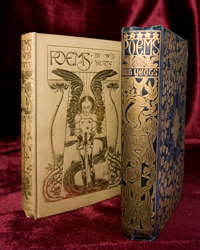Out of the Vault: English professor Kim McMullen explores Riker's Yeats collection
 Kenyon's special collections are a bibliophile's Aladdin's cave, then one of their brightest treasures must be the horde of works of the Irish poet William Butler Yeats, collected by Charles Riker, Kenyon Class of 1927 and professor at the Eastman School of Music. Other libraries hold Yeats's manuscripts, but Kenyon's Riker Yeats Collection is one of the country's richest troves of first editions and limited print editions of Yeats's poetry and prose, several signed or inscribed by the poet ("To Lady Ottoline Morel").
Kenyon's special collections are a bibliophile's Aladdin's cave, then one of their brightest treasures must be the horde of works of the Irish poet William Butler Yeats, collected by Charles Riker, Kenyon Class of 1927 and professor at the Eastman School of Music. Other libraries hold Yeats's manuscripts, but Kenyon's Riker Yeats Collection is one of the country's richest troves of first editions and limited print editions of Yeats's poetry and prose, several signed or inscribed by the poet ("To Lady Ottoline Morel").
Remarkably, represented on these shelves is almost every one of the thirty-six Yeats works published by the Cuala Press of Dun Emer industries. The press was founded by his sisters, Lily and Lollie, in 1903 and run as a fine arts and crafts training school for young Irish women—a Hibernization of the work of William Morris, in whose workshops the sisters studied.
What dazzles most is the breadth and comprehensiveness of the Riker Collection. A Hibernophile as well as a Yeatsian, Riker gathered many first editions by such luminaries of the Irish literary renaissance as Lady Augusta Gregory, John Eglinton, John Synge, Oliver St. John Gogerty, and the future first president of Ireland, Douglas Hyde, who has signed this Dun Emer edition of The Love Songs of Connacht in Gaelic. Equally exciting for a student of Irish history are the rare series of such fin-de-siecle cultural nationalist periodicals as Beltaine.
There are many singular jewels in the Riker Yeats Collection as well. Unfastening an envelope of acid-proof paper reveals a fragile copy of the June 1886 Dublin University Review containing Yeats's first publication—a verse drama entitled Mosada. Opening the covers of Dun Emer's In the Seven Woods, with its title hand-pasted on the front, you are thrilled more deeply than usual by the familiar cadences of "Adam's Curse" and "The Song of Red Hanrahan" because of their proximity to the poet and to the creative processes which produced the very volume in your hand.
And then you discover the red-letter colophon on the final page—"Here ends In the Seven Woods, by William Butler Yeats, printed, upon paper made in Ireland, and published by Elizabeth Corbet Yeats at the Dun Emer Press in the house of Evelyn Gleeson at Dundrum, in the County of Dublin Ireland, finished the sixteenth of July in the year of the big wind, 1903." Unexpectedly, delightfully, you have identified the exact inspiration for James Joyce's satire of Celtic Twilight grandiosity in Buck Mulligan's quip in Ulysses: "That's folk... for your book, Haines. Five lines of text and ten pages of notes about the folk and fishgods of Dundrum. Printed by the weird sisters in the year of the big wind."
But the brown ink of Yeats's own handwriting in the two holographs and several letters in the collection dispels any Joycean skepticism. Tracing Yeats's spidery script—"O curlew cry no more in the air/or cry only to waters in the west"—you are propelled back to the first stirrings of a poem that you know only in later revised and published versions as "He reproves the curlew."
And then there is the mysterious hand-drawn geometric design on the back of a March 31, 1910, letter to "Mr. Carter": could this rough sketch be Yeats's early attempt to work through some of the principles of psychological archetype and historical evolution that emerge in their full complexity fifteen years later in his great cosmologic treatise A Vision?
Each new holograph and volume brings a shiver of imaginative and scholarly quickening that only rare archives like the Riker Collection can produce. In the silence of Olin Library, lost in a Yeatsian reverie, smelling old paper and tracing the loops of a fountain pen on the very page that Yeats himself labored over, you feel the spell of the poet in your deep heart's core.
—Kim McMullen, John Crowe Ransom Professor of English
 Delicious
Delicious Facebook
Facebook StumbleUpon
StumbleUpon Digg
Digg reddit
reddit